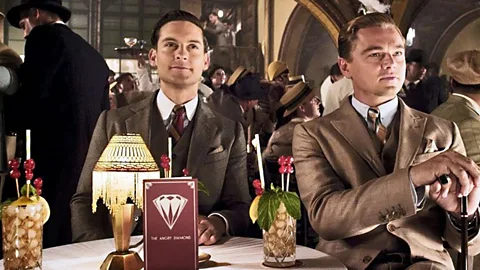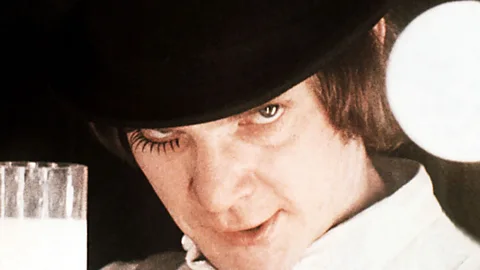Cheers! A celebration of literature’s booziest books

Take a literary cocktail tour with BBC Culture as Hephzibah Anderson reveals how booze and books make such fine bedfellows.
Oscar Wilde wrote of his inordinate fondness for absinthe and Dorothy Parker, who was at her waspish best when she disliked something, was partial to a martini or three (at the most –by four she was famously “under the host”). Ernest Hemingway’s poison was a mojito (among others) and William Faulkner’s a mint julep, while Dylan Thomas reached straight for the whiskey. Again and again and again.
Alcohol plays a well-documented role in literary life – or at least it used to, what with liquid lunches and all-night benders that ended at the typewriter. (The clatter of those keys must have been murder with a hangover, which perhaps explains why certain authors chose to remain drunk instead.)
These days, wordsmiths tend to be a more sober bunch but their reputation for enjoying a nip of this, a flagon of that, and a vat of the other, endures. It’s hardly surprising that some of the stronger stuff has sloshed onto their pages and into their stories. Flip through classics old and new and you’ll find scenes of weepy, wanton, comical, carefree and tragic inebriation, in which beds get set alight (as in Kingsley Amis’ Lucky Jim), bears are tied to policemen and thrown into rivers (Tolstoy’s War and Peace), and wives sold (Thomas Hardy’s The Mayor of Casterbridge). Children’s literature isn’t exempt either – remember when Roald Dahl’s Fantastic Mr Fox led a raid on Farmer Bean’s cider cellar?

Proof reading
Some authors run up a longer bar tab than others. As one Thomas Pynchon devotee has discovered, there’s enough liquor in the Pulitzer Prize winner’s books to generate a dedicated blog. In May, the anonymous fan, who also tweets as @Drunk Pynchon, embarked on a project to imbibe every drink mentioned in every Pynchon novel. Let’s hope he has a strong constitution because Gravity’s Rainbow alone features almost 50 different libations, including something that calls for grain alcohol, beef tea, grenadine, herbal infusions (blue skullcap, valerian root, motherwort and lady’s slipper, no less) and a dash of cough syrup.
It’s the kind of drink you could imagine Raoul Duke and Dr Gonzo consuming on their road trip through southern California in Fear and Loathing in Las Vegas. In fact, it’s pretty much the only thing they don’t drink. Alcohol fumes rise from the page as they wash down a rainbow of pills with everything from beer to tequila. Their baggage includes a pint of raw ether.
And then there’s the Pan Galactic Gargle Blaster’, as invented by Zaphod Beeblebrox in The Hitchhiker’s Guide to the Galaxy. Imbibing this cocktail, Douglas Adams wrote, is “like having your brains smashed out by a slice of lemon”, wrapped “round a large gold brick”, which is no wonder with ingredients like Arcturan Mega-gin, Fallian marsh gas and the tooth of an Angolian Suntiger. Its effects, you might imagine, are every bit as disorienting as the potion that Lewis Carroll’s Alice glugs.
A more refined literary cocktail list might feature a sidecar, as sipped by wealthy Arthur Ruskin in Bonfire of the Vanities, a white angel, which was Holly Golightly’s choice, or a refreshing daiquiri, James Wormold’s order in Graham Greene’s Our Man in Havana. Jay Gatsby prefers gin rickeys while Daisy Buchanan is a mint julep kind of a gal. For Anthony Blanche in Brideshead Revisited, it’s brandy alexanders, that sticky mix of cream, cognac and crème de cacao. Personally, I prefer the sound of the jack roses that boozy Jake Barnes knocks back in Ernest Hemingway’s career-maker, The Sun Also Rises. They’re a mix of applejack, lemon or lime juice, and a splash of grenadine.

There are simpler drinks, too. In On the Road, Dean and Sal hang out in a San Francisco ‘sawdust saloon’ where a guy named Walter orders wine spodiodi, ‘a shot of port wine, a shot of whisky, and a shot of port wine’.
Then there’s the Moloko Plus. Also called a Knifey Moloko, this fictitious tipple comes in many forms but is essentially milk with barbiturates. Featured in Anthony Burgess’s A Clockwork Orange, it’s drunk by the narrator Alex in preparation for “a bit of the old ultraviolence”.

Raymond Chandler’s chess-playing sleuth, Philip Marlowe, keeps things altogether mellower with a gimlet, a recipe for which appears in The Long Goodbye. The drink becomes the glue in a fledgling friendship between the loner private eye and a washed-up playboy named Terry Lennox. “A real gimlet is half gin and half Rose's Lime Juice and nothing else,” Lennox tells Marlowe. “It beats martinis hollow.”
And since he brings them up, it would be remiss not to at least nod to the “very strong” vesper martini that Ian Fleming describes so precisely in Casino Royale. It comprises three measures of gin, one of vodka and a half-measure of the French aperitif Lillet. Shake until ice-cold, then pour into a deep champagne goblet and finish with a twist.
‘In vino veritas’
Of course, authors were dousing their pages with liquor long before the invention of the cocktail. Weave your way back towards the canon’s beginning, and you’ll find the hero of Beowulf defending the king’s vast mead hall against the marauding monster Grendel, who’s seemingly incensed by the drinkers’ din. Mead, if you’ve never encountered it, is a honey-based wine with an ale-like taste, beloved by humans if not Old English ogres.
It pops up in Shakespeare’s plays, too, along with still more obscure wines like malmsey and canary (it really did have a yellow tint, apparently). For that joker Falstaff, though, there was only one tipple: sherry. As he eulogises in Henry IV, Part II, it makes him witty and bold, warms his blood and sets his face aglow. Drunk, in other words.
For authors, on the page though infinitely less so their lives, drunkenness is put to good use, becoming another tool for illuminating their characters’ traits and fates: in vino veritas, as the saying goes. And while it wreaks its fair share of Bacchic destruction (just consider the middle portion of Donna Tartt’s The Goldfinch), in moderation, it can also be a force for good, as when Ebenezer Scrooge offers to share a bowl of Smoking Bishop (that’s port, wine, oranges and spices) with Bob at the end of A Christmas Carol.
If just reading about all this boozy over-indulgence has left you a little tipsy, there’s one drink from Gravity’s Rainbow that might be best: a Shirley Temple.
Cheers!
